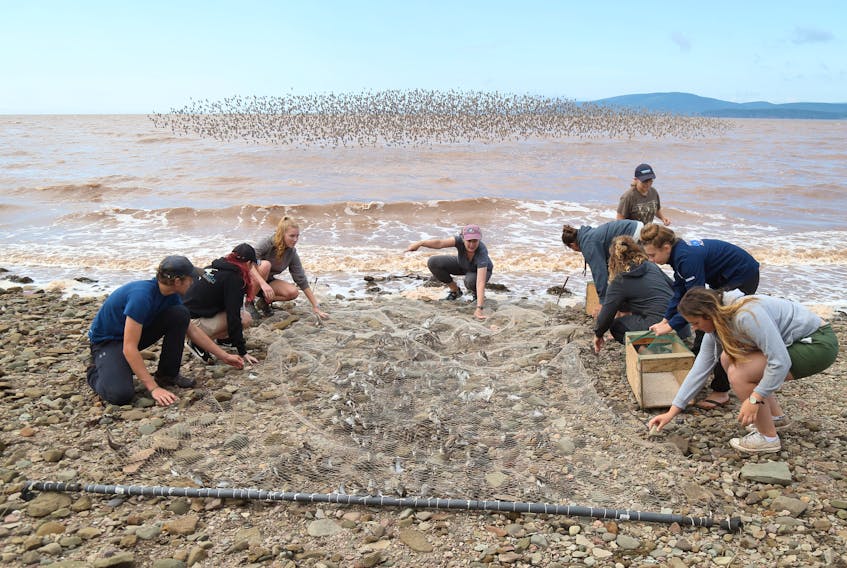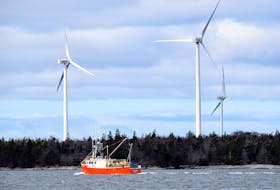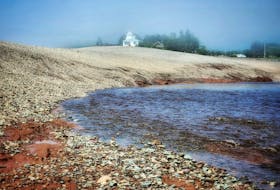AMHERST, N.S. — The mudflats near Minudie and Amherst Point in Cumberland County and in the Cobequid Bay near Truro have gained international recognition with their addition to the Western Hemisphere Shorebird Reserve Network.
“It’s exciting news. It took a long time, but the recognition is well worth the effort,” said Kerry Lee Morris-Cormier, who co-ordinated the application process for the Nature Conservancy of Canada. “It was a unanimous decision from the 18 voting members of the hemispheric council. They said this application from Canada was one of the best they’ve seen and really sets the bar for other international applications for designation. We’re pretty proud. We took our time and we did it right.”
The two new areas, along with two previously recognized areas – Shepody Bay in New Brunswick and the Minas Basin close to Wolfville – have been collectively designated a Landscape of Hemispheric Importance by the Western Hemisphere Shorebird Reserve Network.
The network includes 106 sites in 17 countries. There are six in Canada. It’s an international science-based program that co-ordinates conservation efforts for migratory shorebirds in North, Central and South America.
The new areas include beaches and mudflats at Minudie and Amherst Point and shorelines at Debert, Little Dyke, Fort Belcher and Old Barns, near Truro, where shorebirds rest and feed in summer before migrating south.
“This designation brings awareness to the importance of the habitat in those areas that the birds depend on,” said Cormier, manager of the Nature Conservancy of Canada’s Johnson’s Mills Interpretive Centre near Dorchester, N.B. “Things are healthy in these environments now, but this designation will help make sure that people making decisions that could potentially affect those areas will see a red flag in that these areas are globally important.”
Tens of thousands of shorebirds use the inter-tidal mudflats in July, August and early September to fuel their flight for migration. The beaches and tidal mudflats of the Bay of Fundy are one of the most important stopover sites for shorebirds in North America.
Every summer more than half a million shorebirds fly via the bay on their winter migration from the Canadian Arctic to South America, and feed on the nutrient rich mudflats.
Migrating semipalmated sandpipers weigh about 20 to 25 grams (or half the size of a regular chocolate bar) when they arrive on the mudflats. They stay about three weeks to rest and feed on the beach. They will double their weight in preparation of their 72-hour flight to their final destination.
In the spring, the process is reversed with the birds leaving Brazil and flying north with a stop in Delaware Bay, New Jersey before going back to the Arctic.
The announcement doubles the amount of Fundy habitat designated by the reserve network.
“We would like to thank all the community groups, municipal councils, and federal, provincial and Mi’kmaq governments that supported this effort,” she added. “By working together, we won greater recognition for the plight of shorebirds in the Bay of Fundy and this new designation will help support future conservation work on behalf of shorebirds.”
The recognition of the Fundy coastal habitats is based on results of multi-year research conducted by Mount Allison University, Environment and Climate Change Canada and international researchers — aided by tiny radio transmitters attached to migrating birds — that confirmed how important Bay of Fundy feeding areas are for many species.
Results showed that semipalmated sandpipers in particular are more reliant on beaches and mudflats in Debert and Minudie than previously understood.
Semipalmated sandpiper populations have declined by 50 per cent since the early 1970s, part of a global decline in shorebird populations due to habitat loss, climate change and other factors.
“I applaud the work of the communities, organizations and all levels of government that have come together to support habitat conservation for our declining shorebirds,” Environment and Climate Change Canada Minister Catherine McKenna said in a news release.
Environment and Climate Change Canada will be the Canadian manager of the Bay of Fundy’s Landscape of Hemispheric Importance designation, in partnership with WHSRN.
“As shorebird populations decline, protecting habitat requires international partnerships and more urgent conservation action along their entire migration route, and this is a great example of those partnerships,” Laura Chamberlin, assistant director for the reserve network executive office, said in the release. “This designation doesn’t just expand the geographic boundaries of the WHSRN site, but expands the opportunities for collaboration, ensuring that the Bay of Fundy will continue to provide critical habitat for semipalmated sandpipers to rest and refuel on their journey to their wintering grounds.”
The designation will not change activities permitted on privately owned coastal land, but it will provide a stronger structure for the Nature Conservancy of Canada, other conservation organizations, landowners and all levels of government to work together to protect migratory birds.
NCC’s work to get greater recognition for Fundy shorebird habitats was supported by funding from the Commission for Environmental Cooperation and the Donner Canadian Foundation.









